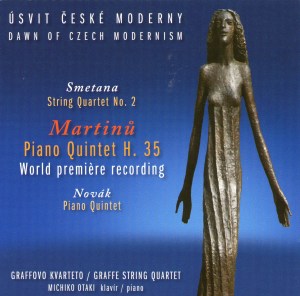 |
 |
|

Availability
CD: Radioservis (Czech Republic)
|
Dawn of Czech Modernism
Bedřich SMETANA (1824-1884)
String Quartet No.2 in D minor [18:18]
Bohuslav MARTINŮ (1890-1959)
Piano Quintet H.35* [18:49]
Vitězslav NOVÁK
(1870-1949)
Piano Quintet in A minor, op.12 [27:56]
 Graffe String Quartet (štěpán Graffe and Lukáš
Bednařík (violins), Lukáš Cybulski (viola),
Michal Hreňo (cello)); Michiko Otaki (piano)
Graffe String Quartet (štěpán Graffe and Lukáš
Bednařík (violins), Lukáš Cybulski (viola),
Michal Hreňo (cello)); Michiko Otaki (piano)
rec. Czech Radio Studio 1, Brno, Czech Republic, 2-4 August 2010
(Martinů, Novák); 7-8 January 2012 (Smetana)
*World première recording
 ČESKÝ ROZHLAS RADIO SERVIS CRO545-2 [65:02]
ČESKÝ ROZHLAS RADIO SERVIS CRO545-2 [65:02]
|
|
|
Czech modernism which flourished between the two world
wars embraced all the arts. Musically however, its roots go
back quite a deal further to the late nineteenth century. This
disc highlights three works that are fine examples of this “movement”.
The Czech lands of Bohemia and Moravia have an extraordinary
tradition of being the cradle of much that was ‘new’
in music. Musical history is teeming with the names of composers
who originated or gravitated to that part of Europe seeing it
as a place for experimentation, innovation and for receptive
audiences for such ideas. The baroque period was particularly
fruitful in producing outstanding composers whose names are
still well known today including Adam Michna of Otradovice,
the Bendas, Biber, Brixi, Černohorsky, the Rejchas, Roessler-Rosetti,
Stamic, Tuma, Vejvanovsky, Jan Zach and Zelenka, to name but
a few; in the 18th century Jan Dismas Zelenka’s name was
mentioned as a worthy successor to Bach. Mozart had his operas
Don Giovanni and La Clemenza di Tito premièred
at the Estates Theatre in Prague, staying there with his friend,
composer František Xaver Dušek and family in their
villa Bertramka. Indeed Dušek taught Mozart’s son
Karl Thomas Mozart.
Add to the above composers the names of the three on the present
disc and those of Dvořák, Fibich, Janáček
and Suk and nearer our own times those of Schulhoff, Krasa,
Klein, Haas, Ullmann, Haba and Eben and it is plain to see the
huge contribution this small country has made to world musical
history. Many of these composers pushed the boundaries in their
time to achieve new ways of performing music. People like Schulhoff
used jazz in several of his compositions in the 1920s and Pavel
Haas even incorporated a jazz band into one movement of a string
quartet! It was natural therefore that this tradition of innovation
should again assert itself towards the end of the 19th
century.
The disc begins with Smetana’s second string quartet.
The author of the booklet notes accompanying the disc, Miloš
Schnierer explains that “daring and progressive tonal/harmonic
devices appear in his (Smetana’s) late creative period,
paving the way for the future” and that this is particularly
in evidence in this quartet. What a wonderful work it is and
I especially love the second movement which is full of folk
polka rhythms. It is the use of folk music that links all three
of the works on the disc. The quartet was given its première
in 1884 and its innovative aspects were admired by none other
than Arnold Schoenberg.
Twenty-seven years later when Bohuslav Martinů wrote his
Piano Quintet things had moved on apace and the Martinů
style was a world away from Smetana’s. The first thing
to say about this work is that it is extraordinary to come across
a work by Martinů that is only receiving its first recording
over one hundred years after its composition! Martinů was
only twenty-one when he composed it in 1911 but his unmistakable
musical signature is there from the very first notes; this work
could be by no one else. With only two movements the quintet
is just 18 minutes in length but abounds in ideas and has some
exquisite tunes, many of them folk-based. The opening of the
second movement is as absolutely gorgeous as it is heartfelt.
This quintet precedes his official No.1 which can be heard with
the second on Naxos 8.557861: Karel Košárek with
the Martinu Quartet.
Novák was a composer, who as someone who was passionate
about his country changed his name from Victor to the Czech
equivalent Vitězslav. His piano quintet, written in 1896
at the age of 26 was his first to incorporate folk rhythms following
a holiday hiking in Wallachia, the border region of Moravia
and Slovakia. What I find particularly interesting about this
quintet are the elements in it that remind one of Smetana at
the same time as there is much that looks forward to Martinů.
Once again it is the second movement that made an impact on
me with its sad quotation of a 16th century folk
song which refers to Novák’s unrequited love for
a singer Josefina Javůrková. The third and final
movement with the subtitle “Slovak” invokes a folk
festival, thrusting us back from sadness to joy. This work placed
Novák firmly at the forefront of turn of the century
Czech musical history. Yet it was the first time I’d ever
heard it and I bet I’m not alone in that though it has
been on a now deleted ASV CD DCA 998 first issued in 1998.
There is so much wonderful music to be discovered. Concert programmers
owe it to composers and audiences alike to uncover some of these
less heard works rather than always sticking to core repertoire
that can be accessed in so many other ways.
The Graffe Quartet played wonderfully as did Japanese pianist
Michiko Otaki. It follows on from their same label and same
artists’ recording of Martinů’s second Piano
Quintet (review).
The present disc, released under Czech Radio’s own label,
was a joy to listen to from start to finish.
Steve Arloff
|
|

